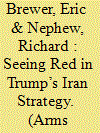| Srl | Item |
| 1 |
ID:
192154


|
|
|
|
|
| Summary/Abstract |
South Korea has long been on the list of potential over-the-horizon proliferation challenges, but growing debates in Seoul about its nuclear options are quickly moving it toward the front of the US nonproliferation agenda. Indeed, proliferation concerns featured prominently at the April 2023 Republic of Korea (ROK)-US summit, where Washington sought South Korean reaffirmation of its “longstanding commitment to its obligations under the Nuclear Nonproliferation Treaty” in return for efforts to bolster extended nuclear deterrence.Footnote1 For decades, calls in South Korea for nuclear armament remained relegated to the political fringes and did not receive serious policy attention. That has begun to change in recent years.Footnote2 South Korean nuclear weapons advocates and those sympathetic to the idea are becoming more numerous, louder, and are increasingly drawn from a broader cross-section of the national security community.Footnote3 In January 2023, South Korean President Yoon Suk-yeol publicly stated that if threats continue to worsen, South Korea might develop nuclear weapons.Footnote4 This is the first time a South Korean president has made such comments. Perhaps most importantly, there has been a subtle evolution of the public discourse, from basic arguments about why nuclear weapons may be desirable to nascent articulations of how South Korea might go about developing them: Seoul’s proliferation strategy.
|
|
|
|
|
|
|
|
|
|
|
|
|
|
|
|
| 2 |
ID:
179189


|
|
|
|
|
| Summary/Abstract |
The Biden administration has a full plate when it comes to nuclear challenges. As of this writing, Iran’s nuclear program is expanding, and the amount of time Tehran would need to produce enough material for a bomb is shrinking.1 Even if a diplomatic solution can be found, Iran is likely to retain a latent capability to build nuclear weapons for the foreseeable future. North Korea’s qualitative and quantitative improvements to its nuclear arsenal—including missiles that can reach the United States—mean that it can no longer be considered a minor nuclear nuisance.2 Evidence suggests that the administration will focus closely on these threats.3 And it would be right to do so.
|
|
|
|
|
|
|
|
|
|
|
|
|
|
|
|
| 3 |
ID:
168010


|
|
|
|
|
| Summary/Abstract |
Since Iran’s May 2019 announcement that it would no longer abide by some nuclear restrictions under the Joint Comprehensive Plan of Action (JCPOA), the Trump administration has sought to push back against these moves by citing the imperative of the JCPOA’s constraints. The JCPOA created limits on Iran’s nuclear fuel cycle that mean Tehran would need a year to produce enough nuclear material for a bomb, and the agreement established enhanced transparency and inspector access throughout the entire fuel cycle.
|
|
|
|
|
|
|
|
|
|
|
|
|
|
|
|